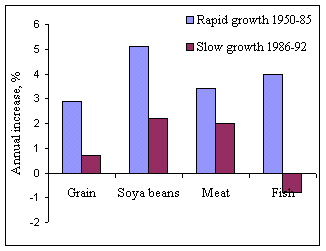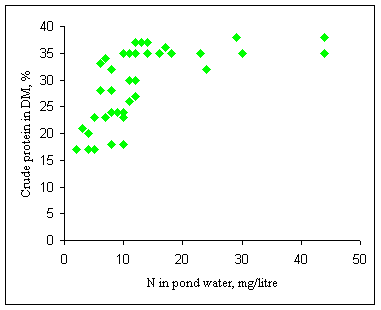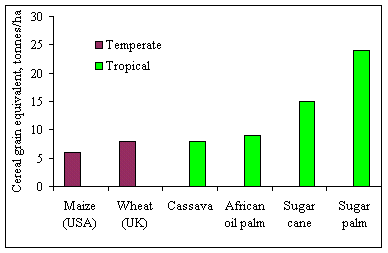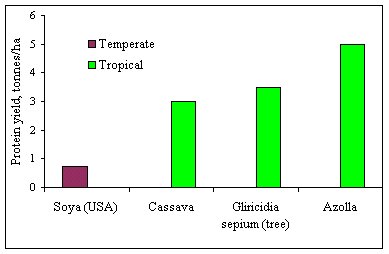| Back to contents |
|
Workshop-seminar "Making better use of local feed resources" SAREC-UAF, January , 2000 |
Livestock Production from Local Resources in an Integrated Farming System; a Sustainable Alternative for the Benefit of Small Scale Farmers and the Environment
Thomas R Preston
University of Tropical Agriculture Foundation and Royal University
of
Agriculture, Phnom Penh, Cambodia
Abstract
“The sun provides us with more energy than we will ever need”. So runs a recent advertisment on the back cover of the July issue of the journal “Renewable Energy World” (1999). As well as providing energy to replace that presently derived from fossil fuel deposits and nuclear sources, the sun can also provide the energy needed to produce the food required for a world population expected to double by the year 2050. The challenge is to capture the sun’s energy in systems of production and utilization which at the same time will contribute to aliviation of poverty, creation of jobs, a more equitable life-syle, protection of the environment and increased biodiversity. This is an impressive list of development targets that should occupy pride of place in the list of priorities of all agriculturists.
Key words: Solar energy, tropics, natural resources, integrated farmiong systems, small scale farmers, livestock
Introduction
The sun is the only sustainable source of
energy, producing more than is needed for both food and fuel needs even with
the projected doubling of the world population. The challenge is to develop ways
of using it as a sustainable alternative to fossil fuel to provide the food and
energy needs of present and future generations.
The approach must be based on:
$ Selecting and promoting crops and farming systems which optimize use of natural resources without depleting them
$ Matching the production system with the available resources
$ Recognizing that poverty, and not food, is the major constraint to equitable development
Food production
The World Food Summit convened by FAO in Rome in 1997 predicted that food and feed production in developing countries must be tripled by the year 2050 to cater for the demand created by the expected doubling of the human population and their increasing aspirations for a higher standard of living.
The means that were proposed to meet this target (Table 1) were justified on the basis of linear projections of world production data over the last 4 decades which indicated that such increases in productivity were feasible.

A closer examination of the basic data reveals that the trends in food production over this time phase are not linear. In fact, two trends should be fitted to these data. The first describes the high growth period from the ‘50s to the ‘70s (the time of the “green revolution”) and the second relates to the post “green revolution” era (Figure 1) when rates of increase in major food commodities declined markedly (and were even negative in the case of fish) to levels which will not sustain the proposed needs (Brown and Kane 1994). Rates of increase in production have declined because of reduced areas under cultivation and reduced inputs, especially of fertilizers (Figure 2), due to marginal yield responses to inputs as crop production rates reach their biological limits.

Figure 1: Tendencies in production of commodities; periods of rapid (1950-85) and slow (1986-92) growth (Source: Brown and Kane 1994) |

Figure 2: Tendencies in availability of basic agricultural resources; periods of rapid (1950-85) and slow (1986-92) growth (Source: Brown and Kane 1994) |
It must also be recognised that intensive cereal grain production is heavily dependent on inputs derived from fossil fuel (Figure 3).
|
Figure 3: Use of energy for grain production; "modern"vs "traditional" |
For every 18 MJ of the food energy in 1 kg of rice produced in the USA the input in fossil fuel-derived inputs is 12 MJ ... approximately two thirds. By contrast, the fossil fuel needs in traditional rice production in Asia and Latin America are little over 1% of the energy in the grain.
|
Figure 4: Actual (to 1997) and predicted world oil production (Source: Campbell 1997) |
Fossil fuel supplies are presently at their peak level and in 10 to 15 years time will begin to decline (Figure 4). Prices will inevitably rise, which will have serious consequences for cereal grain production particularly in the industrialized countries in temperate latitudes which are the major cereal producers.
An alternative approach
What can be done to meet the food needs of the doubled world population without concomitant increases in cereal grain production and resultant negative effects on the environment? The present livestock production systems in most industrialised countries (New Zealand and parts of Australia are the exception) are directly in competition with human needs. Livestock presently consume almost 50% of world cereal grain supplies (Sansoucy 1998). In the “intensive” large scale production systems, increasingly promoted by corporate agriculture, livestock wastes contaminate soil and water resources, create less than favourable working conditions for the personnel involved in feeding and cleaning, and decrease employment opportunities.
The solution to the problem of meeting food needs in 2050 is to develop livestock production systems which do not depend on cereal grain. Feeding grain to livestock is a recent phenomenon. It is neither necessary nor desirable. Alternative non-grain systems will lead to reduced contamination of the environment, increased employment opportunities (for families), enhanced biodiversity and better quality of livestock products.
Selecting and using non-grain natural resources for livestock production
Energy crops
In tropical countries where population growth is concentrated, there are many crops and farming systems that considerably exceed the productive capacity of grain cereals (Figure 5).
|
Figure 5: Comparative crop yields (energy): temperate vs tropical latitudes |
Key crop plants and trees in this scenario are:
$ Sugar cane
$ Cassava
$ The palm family especially the Oil and Sugar Palms
The yield potential of the sugar palm (Borassus flabellifer) is extremely impressive. An annual average yield equivalent to 18 tonnes of soluble sugars per hectare has been documented in a study with 12 family farm households in Cambodia (Figure 6). Yet despite this demonstrated potential almost no research is currently conducted to improve the technology of growing and using this tree which is found throughout the SE Asia region.
|
Figure 6: Yield of juice from sugar palm trees harvested by small-scale farmers |
Protein crops
There is an equally great potential to produce high yields of protein in the tropics. But this will be with trees and shrubs and water plants rather than with soya beans (Figure 7).
|
Figure 7: Comparative crop yields (protein): temperate vs tropical latitudes |
The Lemnacaea, of which “duckweed” is the most widely distributed, have a particularly important role to play in livestock production because of their capacity to extract nutrients from water fertilized with wastes (excreta) from livestock and people (Leng 1999). A specific feature of this plant is that its protein content can be manipulated according to the nutrient supply in the water (Figure 8). Values in the range of 35 to 40% protein in the dry matter can be attained when the nitrogen content of the water is in the range of 20 to 30 mg/litre.

Figure 8: Relationship between N content of pond water and crude protein in duckweed dry matter (Source: Leng 1999) |
Duckweed is easy to harvest and needs no processing prior to being fed to livestock. The protein is highly digestible and the excellent balance of essential amino acids makes it an ideal supplement for chickens, ducks and pigs (Bui Xuan Men et al 1996; Rodriguez and Preston 1997; Nguyen Duc Anh and Preston 1998). Average yields are of the order of 100 g fresh biomass/m²/day equivalent to up to 8 tonnes of protein/ha/year (Figure 9).

Figure 9: Production of duckweed protein in ponds fertilized with biodigester effluent in Cantho, Mekong delta (Source; Khang et al 2000) |
The cassava plant (Manihot esculenta) can be managed as a
perennial forage crop with repeated harvests of the foliage at 50-70 day
intervals. The foliage yield increases
over successive harvests (Figure 10) as the repeated cutting stimulates new
growing points. Yields of 3-4 tonnes of protein/ha/year are possible with this
regime.

Figure 10: Production of foliage from cassava managed as perennial shrub for protein production in South Vietnam (mean harvest interval 52 days) |
The fresh foliage is an excellent protein source for ruminants (Ffoulkes and Preston 1978), while after ensiling (which converts the toxic cyanide into non-toxic cyanates) it can safely be fed to pigs (Du Thanh Hang 1998). Cassava is an exploitive crop when grown in monoculture and on sloping land. Managing it as a perennial shrub / tree and associating it with N-fixing legumes, such as Flemingia macrophylla or Desmanthus virgatum (Khieu Borin and Lylian Rodriguez, unpublished data), or fertilizing it with heavy dressings of livestock manure or biodigester effluent (Le Ha Chau 1998) are ways in which it can be grown sustainably with enhancement of soil fertility. The presence of the cyanogenic glucosides in the leaves may serve as an “organic” pesticide apparently providing protection against a wide range of pests.
Changing the livestock
system
The feeds derived from these “alternative” crops (juice from sugar cane and sugar palm, roots of cassava, fruit from oil palm, duckweed biomass and cassava foliage) do not lend themselves to “factory” farming systems which traditionally use dry feeds, which are easy to store, transport and mix into “least-cost” rations. The “alternative” feeds require “alternative” farming systems. These will be small-scale and can be highly productive. They will be diversified and integrated (Figure 11) and the role of animals in these systems will be synergistic rather than as primary producers. Emphasis will be on “small” livestock.

Figure 11: Flow diagram of an integrated farming system |
|
Primary beneficiaries of these systems will be women and children, who will benefit from biogas technology (cleaner cooking utensils and smokeless kitchens) and the merging of family and farming activities. External inputs will be minimised through waste recycling, and growing of nitrogen-fixing and pest-resistant plants in the farming system. Biodiversity will be enhanced as the “alternative” feeding systems, using mainly local plant resources, will provide comparative advantages to indigenous animal ecotypes (Rodriguez and Preston 1997) and opportunities for greater use of indigenous knowledge.
Information technology
There are strong vested interests that favour corporate (large scale) investment in, and management of, agricultural activities, despite the evidence that small-scale family farms are more productive and are socially desirable (Rosset 1999). The rejection by consumers in Europe of foods derived from genetically modified crops highlights the importance of access to information. It was the public debate about “GM” foods that resulted in the reaction from consumers.
The rapid development of cellular phone technology, especially in poor countries (Iqbal 1999), coupled with global linkages via the Internet, is an opportunity for rural communities to have access to relevant knowledge and to share in the multi-media activities previously available only to urban dwellers. Initiatives such as the Village Information and Training Project (VITP) advocated by FAO and IFAD (Andrew Speedy, unpublished data) and the Village Knowledge Centres presently being promoted by the Swaminathan Research Foundation in India (K Balasubramanian, personal communication), should be strongly supported because of their potential impact in “levelling the playing field” between rural and urban communities. They are appropriate for ensuring that families engaged in small scale integrated farming systems have equal access to information and learning opportunities as those in the corporate farming sector.
References
Brown L and Kane H 1994 Full house: a reassessment of the earth's population carrying capacity. Earthscan Publications Ltd: London
Bui Xuan Men, Ogle B and Preston T R 1996 Duckweed (Lemna spp) as replacement for roasted soya beans in diets of broken rice for fattening ducks on a small scale farm in the Mekong delta. Livestock Research for Rural Development (8) 3:14_19
Campbell C J 1997 Better understanding urged of rapidly depleting reserves. Oil and Gas Journal () April 7:51_54
Du Thanh Hang 1998 Ensiled cassava leaves and duckweed as protein sources for fattening pigs on farms in Central Vietnam. Livestock Research for Rural Development (10) 3: http://cipav.org.co/lrrd/lrrd10/3/hang2
Ffoulkes D and Preston T R 1978 Cassava or sweet potato forage as combined sources of protein and roughage in molasses based diets: effect of supplementation with soybean meal. Tropical Animal Production. Volume 3, Number 3: 186-192
Le Ha Chau 1998 Biodigester effluent versus manure from pigs or cattle as fertilizer for production of cassava foliage (Manihot esculenta). Livestock Research for Rural Development (10) 3: http://cipav.org.co/lrrd/lrrd10/3/chau1
Le Ha Chau 1998 Biodigester effluent versus manure, from pigs or cattle, as fertilizer for duckweed (Lemna spp.). Livestock Research for Rural Development (10) 3:http://cipav.org.co/lrrd/lrrd10/3/chau2
Leng R A 1999 Duckweed: A tiny aquatic plant with high potential for agriculture and evironment. Animal Production and Health Series. FAO, Rome No: 143
Mai Kim Dinh 1995 Unpublished data. University of Cantho, Vietnam
Nguyen Duc Anh and Preston T R 1997 Evaluation of protein quality in duckweed (Lemna spp.) using a duckling growth assay. Livestock Research for Rural Development (9) 2: http://www.cippaav.org.co/lrrd/lrrd9/2/anh92
Quadir Iqbal Z 1999 Connecting Bangladeshi Villages. Livestock Research for Rural Development (11) 1: http://www.cippaav.org.co/lrrd/lrrd11/1/qua111.htm
Pretty J N 1995 Regenerating agriculture _ Policies and Practice for Sustainability and Self_reliance. Earthscan Publications Ltd: London. pp: 320
Rodríguez Lylian and Preston T R 1996 Comparative parameters of digestion and N metabolism in Mong Cai and Mong Cai Large White cross piglets having free access to sugar cane juice and duck weed. Livestock Research for Rural Development (8)
Rodríguez Lylian and Preston T R 1997 Local feed resources and indigenous breeds: fundamental issues in integrated farming systems; Livestock Research for Rural Development (9) 2: http://www.cippaav.org.co/lrrd/lrrd9/2/lylian92
Sansoucy R 1995 Livestock _ a driving force for food security and sustainable development. World Animal Review. "50 years". Volume 84/85, No 2.
Shell 1999 Connecting you to the sun. Renewable Energy World. Volume 2, Number 5 (back cover)
World Food Summit 1996 International Conference on Food Security. FAO, Rome




